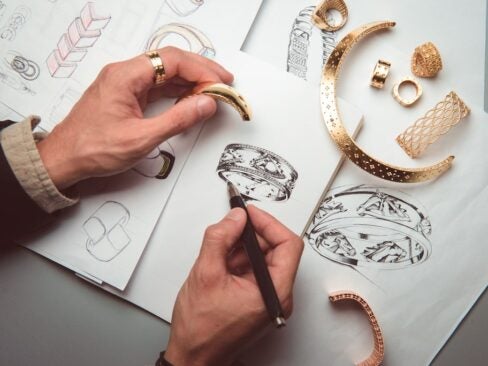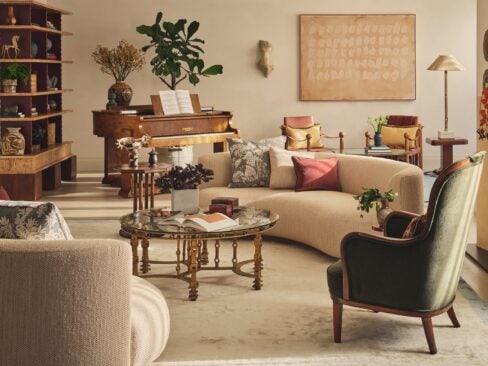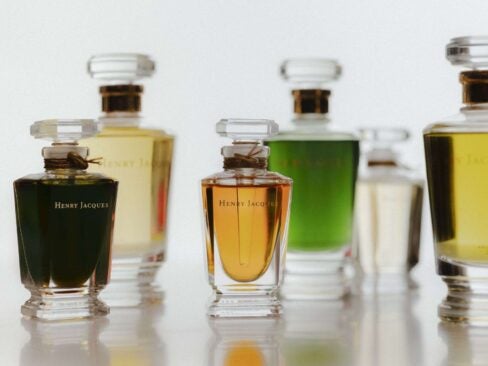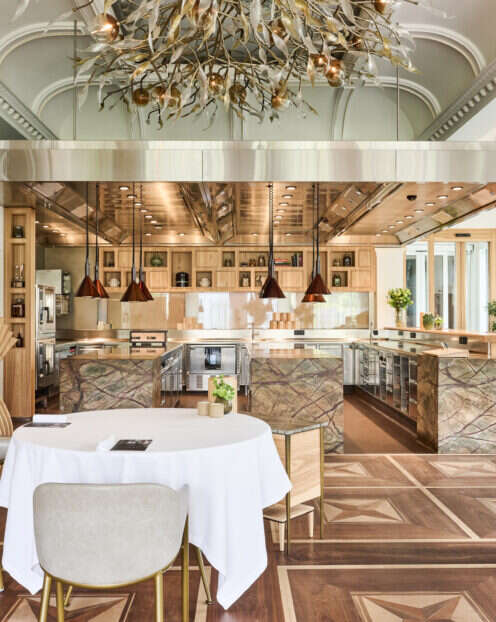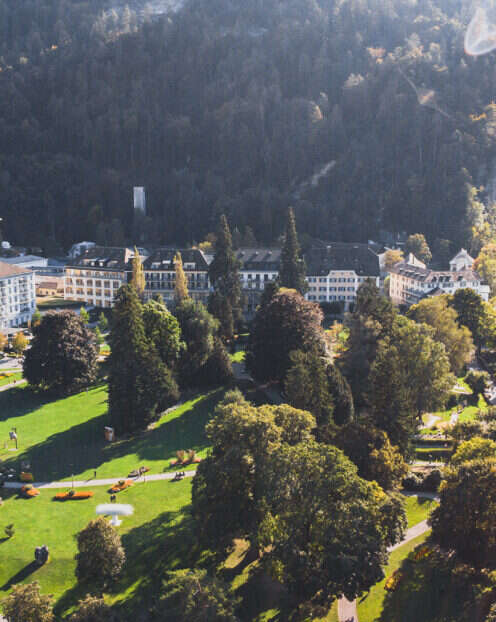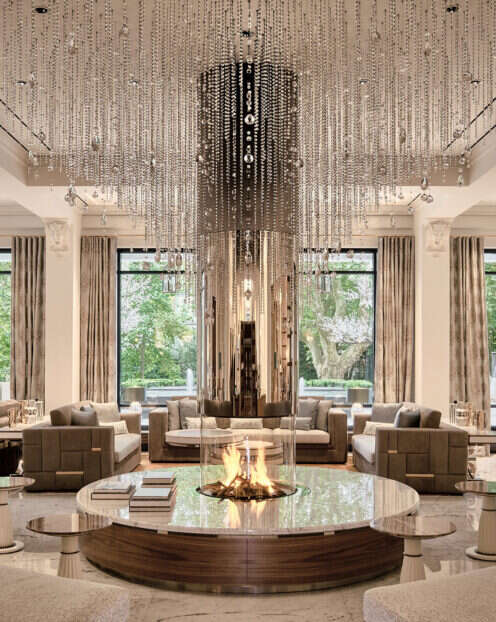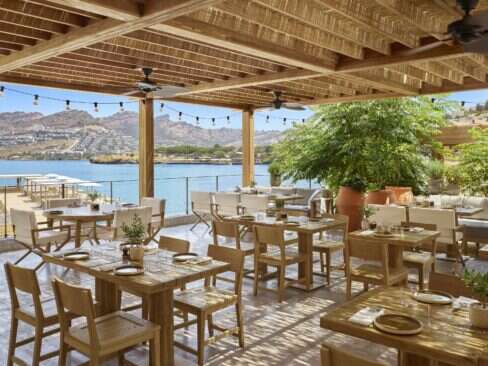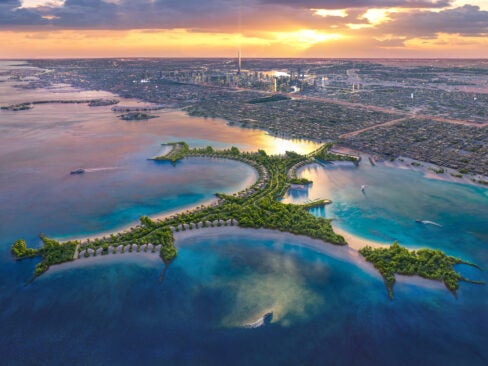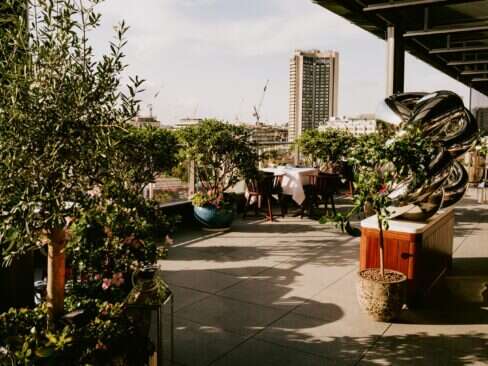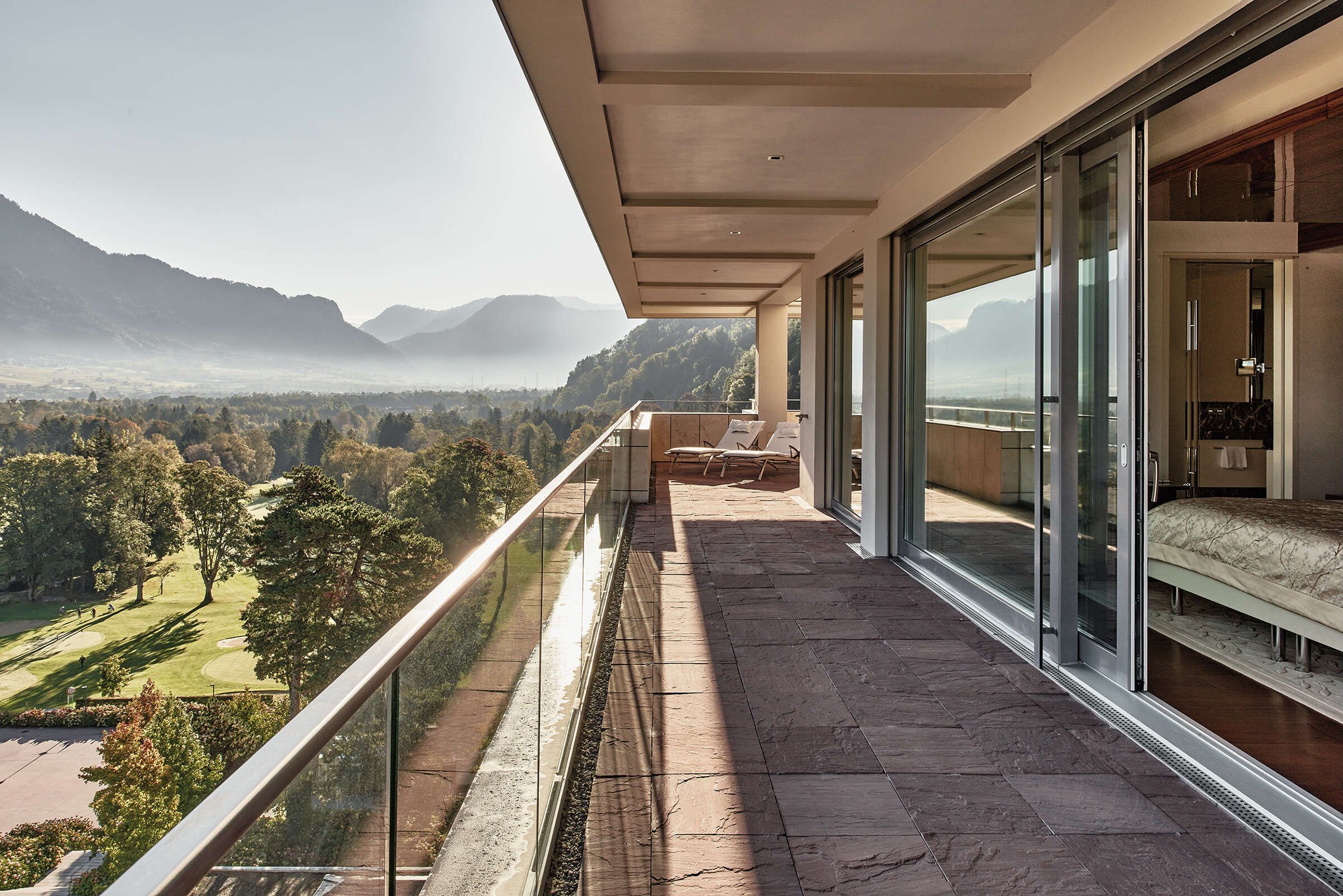
This part of Switzerland, nestled up to Liechtenstein and the Austrian border, with its soaring peaks, glimmering lakes, and pristine expanses of green unfurled across a spectacular landscape like huge luxurious carpets, has an unreal quality to it all. Enveloped in calm, bathed in an ever-changing light, and gently tick-tocking along with that famously just-so-Swiss precision, it’s like having trekked to Europe’s Shangri-La. As if to underline its tenuous relationship with reality, it’s now even called Heidiland in homage to the 19th-century fictional character whose adventures were set here.
In the midst of all this pastoral perfection sits one of Europe’s longest-established and highly revered wellness retreats, Grand Resort Bad Ragaz, on the edge of the pretty little town of the same name. The town’s association with the healing powers of nature extends back to the 13th century when hunters discovered mineral-rich thermal waters gushing out of the nearby Tamina Gorge. Its hydrating health benefits have been luring visitors ever since.
In 1868, the architect Bernhard Simon constructed the Grand Hotel Quellenhof, piping the thermal water, flowing out of the ground at a constant 97.7 degrees, directly into his beautiful Belle Époque Helena Bad, Europe’s first indoor thermal pool. In a typically sensible Swiss maneuver, the town allowed him to do this in return for constructing the Tamina Therme, for local people to access, right next to his luxury hotel. It’s an arrangement that survives, with the recently renovated 92,000 sq ft public spa, which resort guests also have access to, full of Swiss of all ages, eagerly grabbing their share of the water’s life-giving properties.
Sprawling across nearly 200 acres, Bad Ragaz remains a demonstrably ungated community. With its manicured lawns discreetly dotted with sculptures, merging seamlessly into the streetscape, it’s as if you’ve simply strayed into the fancy part of town.
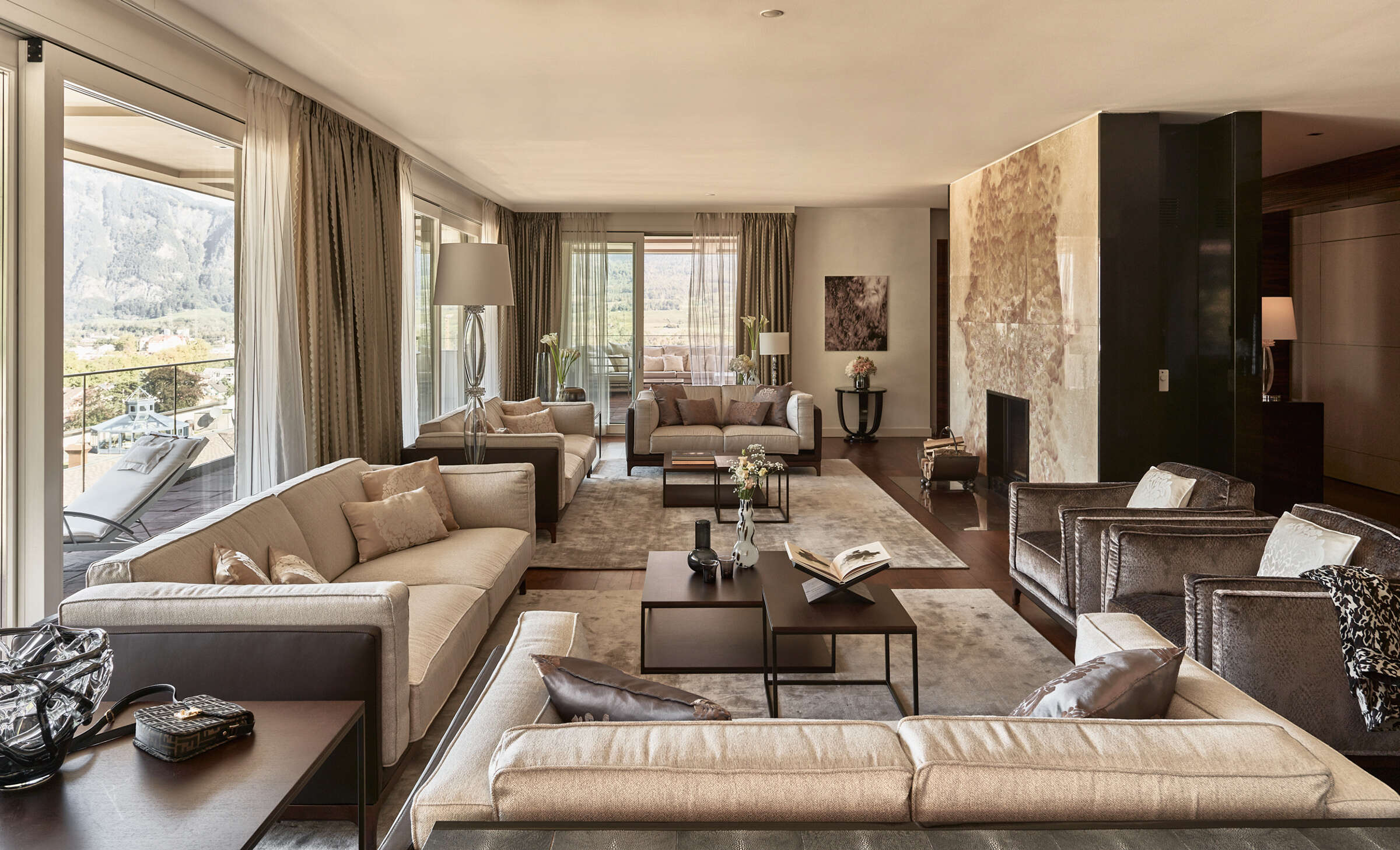
Stay
The resort is comprised of the Quellenhof, the Grand Hotel Hof Ragaz, the 18th-century Hotel Palais, and the modern Spa Suites, the first four floors of which are a fully equipped medical center. There are two golf courses, seven restaurants, a casino, tennis courts, 12 pools fed daily by nearly 2 million gallons of water, and the extensive spa facilities of the thermal baths. Since its inception, Grand Resort Bad Ragaz, which is also used as a retreat by the Swiss Olympic team, has been inviting celebrities and the wealthy alike, to disappear into its discretion-assured watery wonderland in the expectation of reemerging in better shape, better looking, or both.
The main entrance is at the Quellenhof, on the roof of which is a huge sign spelling out: ‘Everything’s Going To Be Alright.’ It looks more than a little incongruous in prim and proper Heidiland. Far from some sort of reassuring welcome for a nervous Gulf Royal arriving for his complex cosmetic surgery, however, it is, in fact, an artwork by British artist Martin Creed. The prominently positioned piece is emblematic of a whimsical informality embedded into a property that, at first sight, might otherwise appear conservative and conventional.
There are 247 rooms and suites ranging across the recently remodeled Grand Hotel Hof Ragaz, to the period charm of the Hotel Palais, and the ultra-contemporary spa suites, where the spectacular Penthouse Suite, which can be further expanded into a supremely opulent space totaling 5400 sq ft, commands breathtaking views through floor-to-ceiling windows.
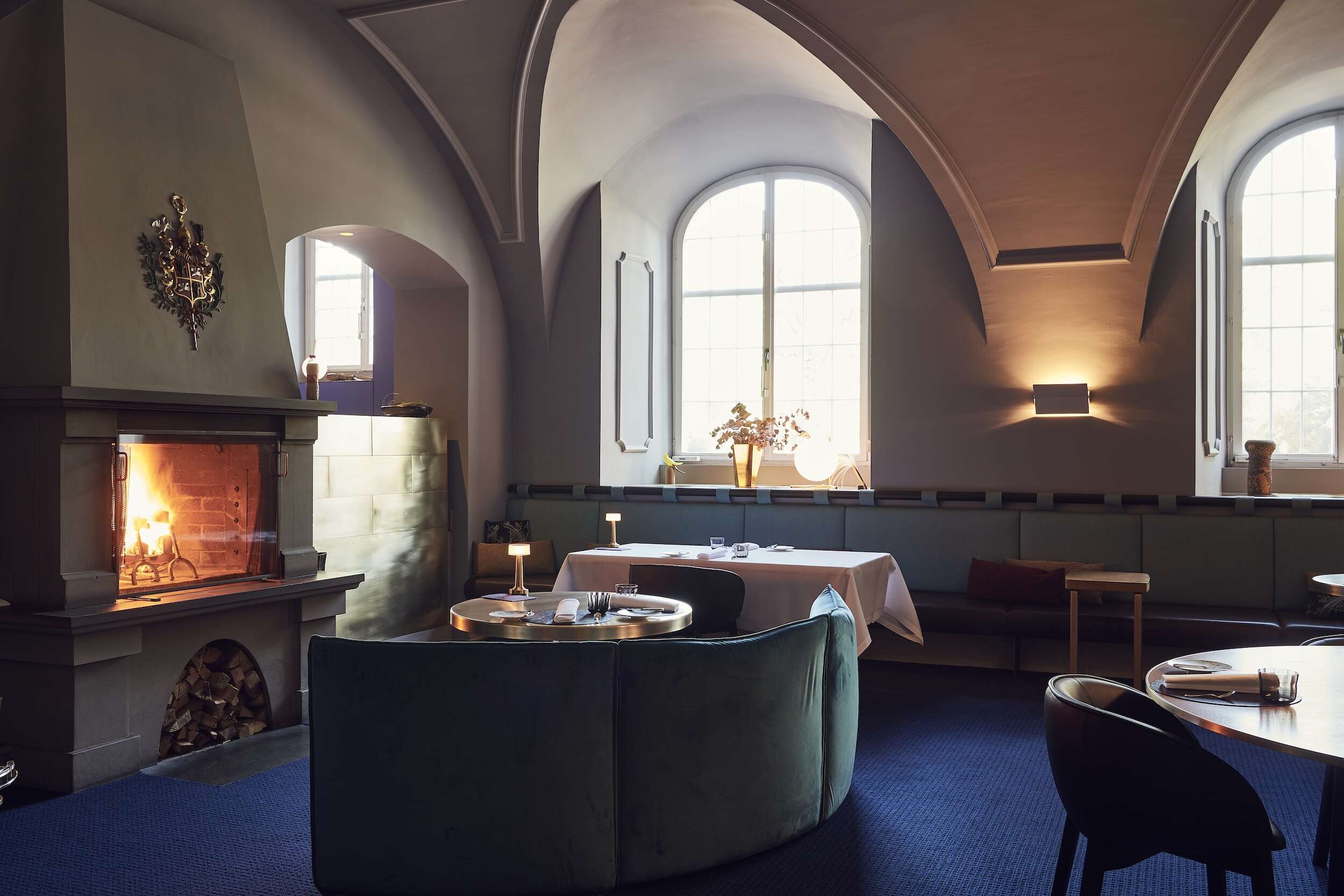
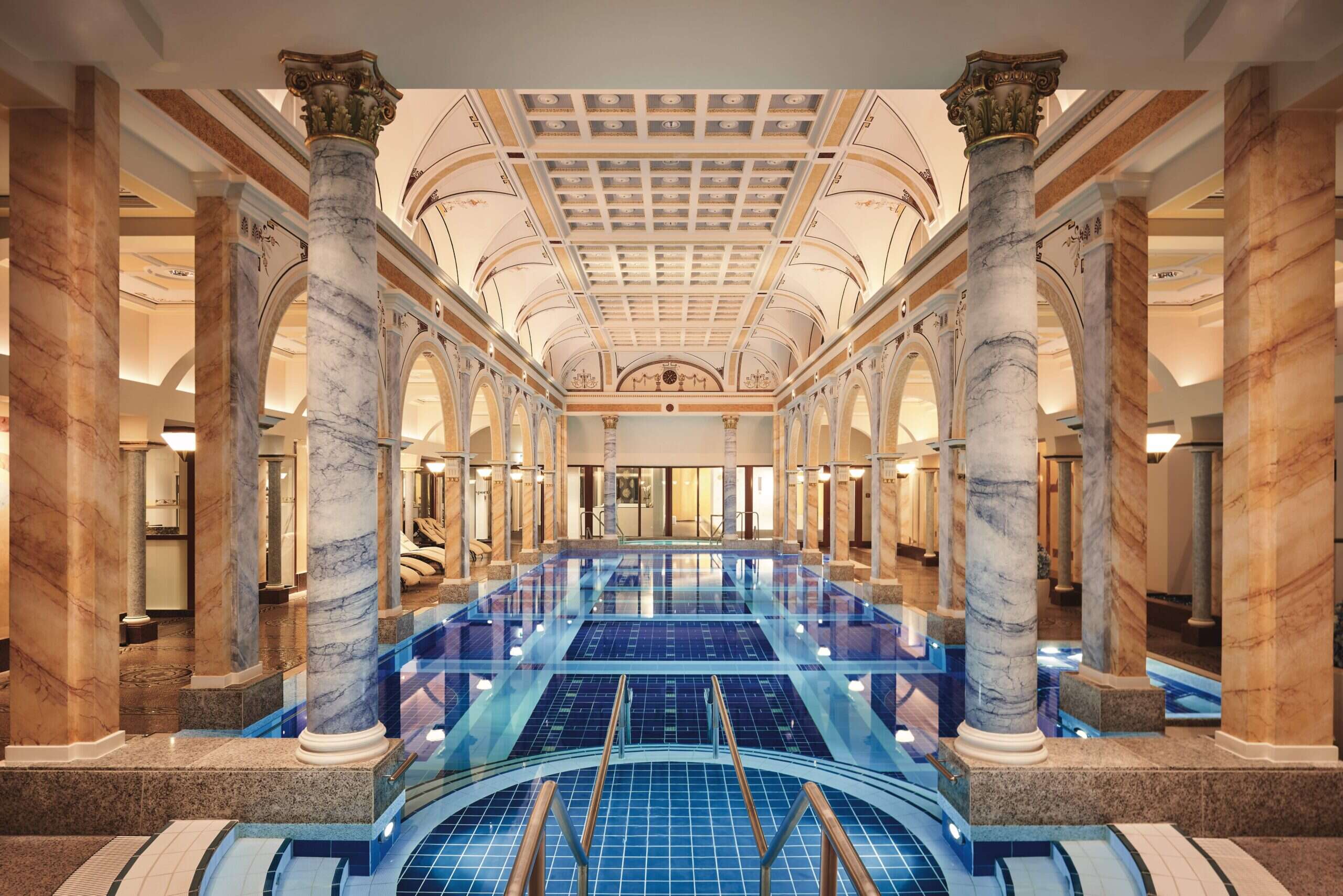
Dine
To say that guests at Grand Resort Bad Ragaz or the resort are well served gastronomically is a little disingenuous. Basically, they’re spoiled by the presence of not just one but two of the four chefs in Switzerland to hold three Michelin stars. Andreas Caminada, whose 3-starred flagship is at nearby Schloss Schauenstein, oversees IGNIV, brandishing two Michelin stars. Showcasing a sophisticated, contemporary cuisine anchored around local produce such as the pike perch and trout from the nearby Walensee Lake, traditional menus are eschewed in favor of small sharing plates. Stylishly conceived by Milan-based designer Patricia Urquiola, IGNIV, meaning nest in the Swiss Romansch language, also acts as one of Caminada’s crucibles for mentoring young chefs.
One such rising talent formerly under Caminada’s tutelage at Schloss Schauenstein, Sven Wassmer, is now Bad Ragaz’s Culinary Director, overseeing two restaurants at the resort: Sven Wassmer Memories, with 3 Michelin stars (plus a green star), and 1-starred, Verve By Sven.
Still only 38 years old, Wassmer is credited with forging a newly refined Swiss Alpine cuisine whose ties to seasonality and locally sourced produce veer towards the obsessive. Citing René Redzepi of the iconic, and now closed, Copenhagen restaurant, Noma, as a major influence, in the same way that the Danish super-chef reinterpreted Scandinavian cuisine, Wassmer, featuring ingredients like pine, fir, and berries, has been hailed as Redzepi’s Alpine acolyte. His wife, Amanda, is also the sommelier at Memories, whose induction into the wonderful world of Swiss wine ensures an exceptional and singularly Swiss gastronomic experience.
Relax
A picture-postcard town nonchalantly pottering about its business; the distant thwack of a golf club; a contended splash from a nearby pool –the Grand Resort is, and always has been, a haven of relaxation. The cosmetic and medical connections are ever-present, but when Simon built his spectacular Helena Bad, so named for his unrequited love of the Russian tsar’s sister-in-law, it was for guests to come and wallow in its warm healing waters and feel the weight of the world slowly fade away. They still do.
This is also spa and sauna Nirvana. In addition to three steam rooms, there’s a bio sauna, infra-red sauna, Switzerland’s largest kelo infusion sauna, where infusions are poured onto hot stones, a sanarium, the nera ritual sauna, the Latvian pirts sauna, which I think involves skin peeling, and the quaintly entitled textile sauna, for those unable to get with the program and go fully naked. After negotiating your way, textiled or untextiled, around all that, you can then cool off in the ice grotto or an outdoor pool.
There’s also a multitude of treatments that are as indulgently relaxing or as wellness-focused as you wish. From the in-house Tamina flow massage, and the New You curated lifestyle program, to an internal organs massage, hyperbaric oxygen therapy delivering 14 times more oxygen than usual, or just getting your food intolerances assessed, the overall impression is that, if it’s not available at Grand Resort Bad Ragaz – it probably doesn’t exist.
Explore
The breathtaking Alpine landscape, visible at every turn, withholds a plethora of outdoor possibilities, from serious trekking in the Sardona UNESCO World Heritage site where chamois and eagles might be spotted, to a stroll along the nearby river Rhine, which here merely hints at the mighty waterway that will eventually commandeer the bottom half of Holland before disgorging itself into the North Sea. On its rougher reaches, rafting is possible, while on the Walensee, boat excursions proffer a more sedate aquatic adventure.
On the opposite bank of the Rhine is the Bündner Herrschaft wine region, from where much of the wine at Bad Ragaz is sourced. The quality of Swiss wine can be a revelation, something that the Swiss seem to keep to themselves. Part of the isolationist mentality, perhaps; if we’re going to keep ourselves to ourselves, we might as well do it in style and hold on to all the good stuff! Guides are on hand for vineyard tours, though I enjoyed a delightful afternoon sauntering around the Bündner Herrschaft on one of the hotel’s e-bikes.
Switzerland’s oldest town, Chur, is 20 minutes away, and is the start point for the Bernina Express railway, the highest in Europe, and undoubtedly one of the most spectacular train trips anywhere. Along the steepest tracks in the world, it negotiates 55 tunnels and 196 bridges down to the Italian town of Treviso, and is definitely worth undertaking, if only for a section of the route.
In Winter, there’s extensive cross-country skiing outside the door, with 26 miles of pistes at nearby Pizol, while the resorts of Klosters, a long-time favorite of British royals, and Davos, are just half an hour away.
Every corner of the resort is infused with art, for which a digital guide is available, though personalized art tours with the hotel’s dedicated art commissioner, Alexa Ritter, are also possible. Alexa will walk guests around the interiors as well as the expansive sculpture-laden grounds, elucidating the vast array of artworks, including, of course, Everything’s Going To Be Alright, which it most definitely will be. They’ve been making sure everything’s alright at Bad Ragaz for over 150 years.
Penthouse Suite starting from 12,500 CHF (approx. $15,300) a night. Click here to book now. Elite Traveler may earn commission if you book through the link.


